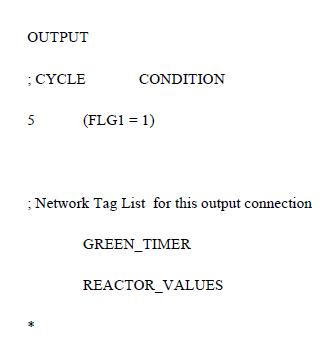The OUTPUT section defines the NTs the console workstation is to send out to the master so that the rest of the system can access them. Only console workstations have OUTPUT sections. The OUTPUT section of the configuration file must be preceded by the keyword OUTPUT. After this keyword has been read in, the program will assume that all the following connections that are defined are output connections. The following example defines an output connection:

Each connection has a starting line, on which two fields are defined. The first field is the cycle time, which controls how often the conditional will be executed. If the cycle field is 5, for example, then the conditional will be checked every 5 cycles of the program. (Note that cycle lengths are defined in the header section, as documented above.) The second field on the starting line is a conditional, enclosed in parenthesis.
After the starting line, the output connection definition can continue for any number of lines, each of which contains the name of an NT that was defined in the NT list. The NTs in the list can only be from those defined previously in the file. The end of the output connection is signaled by an asterisk (*) on a separate line. After this, another output connection can be defined.
In the preceding example, the meaning of the connection is as follows: Every fifth cycle, check to see if FLG1 is ON. If FLG1 is ON, then check all the ONSPEC values associated with GREEN_TIMER and REACTOR_VALUES for changes. If any of these values have changed since the last time the value was sent out, then send the new value to the master workstation.
IIt is not necessary to put the OUTPUT keyword into the file more than once. Every connection listed after this keyword will be assumed to be an output connection, until a different keyword is found.